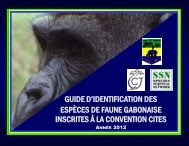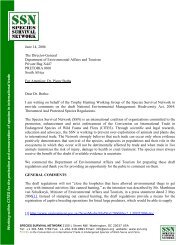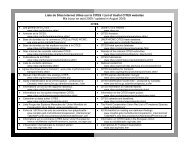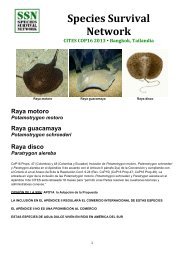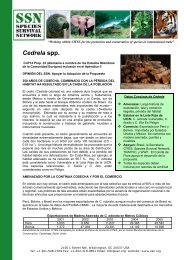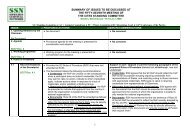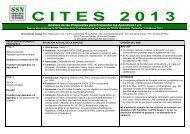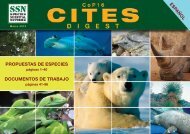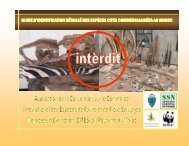CITES CoP16 Digest - Species Survival Network
CITES CoP16 Digest - Species Survival Network
CITES CoP16 Digest - Species Survival Network
Create successful ePaper yourself
Turn your PDF publications into a flip-book with our unique Google optimized e-Paper software.
SPECIES/PROPONENT/PROPOSAL CURRENT STATUS OF SPECIES SSN VIEW<br />
Prop. 22<br />
Laughing owl<br />
Sceloglaux albifacies<br />
• Distribution: New Zealand.<br />
• Population: Extinct (IUCN 2012); last recorded in 1914.<br />
• Threats: Habitat conversion.<br />
• Trade: No trade recorded.<br />
OPPOSE<br />
• AC endorsed this proposal under Periodic Review of the Appendices (RC<br />
14.8).<br />
• SSN agrees with the Secretariat that, “as this species is presently<br />
included in Appendix II under the Order-level listing of STRIGIFORMES<br />
spp., its exclusion from that Appendix may have the effect of complicating<br />
the Appendices rather than simplifying them.”<br />
New Zealand<br />
Deletion from Appendix II<br />
Prop 23<br />
American crocodile<br />
Crocodylus acutus<br />
Colombia<br />
Transfer from Appendix I to Appendix II, Colombia’s<br />
population of the Bay of Cispata<br />
• Distribution: Widely distributed; Peru, Ecuador, Colombia, Venezuela,<br />
Panama, Costa Rica, Nicaragua, El Salvador, Honduras, Belize, Guatemala,<br />
Mexico, USA, and some Caribbean islands; in Colombia, prefers mangroves<br />
and river deltas; Bay of Cispata population occupies 1,436 ha (12.5%) of<br />
bay’s mangroves; since 2000 has been subject of community-based conservation<br />
activities aimed at eventually supplying international skin trade.<br />
• Population: Vulnerable (IUCN 2012); increasing trend globally but depleted<br />
with limited recovery in Colombia; proposal notes increase in average<br />
number of sightings from 2002-2011; 221-231 in 2011 compared to 93, 103,<br />
and 122 in 2008, 2009, and 2010, respectively; species density increased<br />
from ~1/km in 2010 to slightly less than 2/km in 2011; increase related<br />
to release program initiated 7 years ago; 3,000- 3,438 released; recovery<br />
efforts improved in 2008, particularly for younger animals; installation of<br />
artificial nests has reduced the number of failed nests; number of eggs/nest<br />
increased 17% 2004-2012 but number of hatchlings/nest declined from 19<br />
in 2004 to 13 in 2012.<br />
• Threats: Hunting for international hide trade, habitat degradation, predation.<br />
• Trade: Capture prohibited in Colombia since 1965 (illegal capture for local<br />
use continues); prior to this ~2 million skins traded internationally; currently<br />
6 Colombian farms registered with Secretariat have exported 647 skins<br />
since 1994.<br />
OPPOSE<br />
• Population small (221-231) and concentrated in one small area.<br />
• Meets criteria for Appendix I in RC 9.24 (Rev. CoP15), Annex 1 A ii) and iii).<br />
• RC 9.24 (Rev. CoP15), Annex 4 (A) (2) states, “<strong>Species</strong> including in<br />
Appendix I should only be transferred to Appendix II if they do not satisfy<br />
the relevant criteria in Annex I…”<br />
• Proposal indicates population is recovering; but still small enough to<br />
meet Appendix I criteria; not large enough to supply skins for international<br />
trade.<br />
www.ssn.org<br />
11



